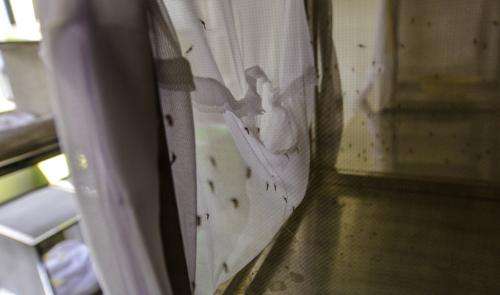Second door discovered in war against mosquito-borne diseases

(Phys.org) —In the global war against disease-carrying mosquitoes, scientists have long believed that a single molecular door was the key target for insecticide. This door, however, is closing, giving mosquitoes the upper hand.
In this week's Proceedings of the National Academy of Sciences, a team of researchers led by Michigan State University has discovered a second gateway that could turn the tide against the mosquitoes' growing advantage.
For many years, pyrethroid insecticides have been deployed in developing countries to fend off diseases such as malaria, dengue fever and more. They're so effective that they are the only insecticides the World Health Organization uses with their mosquito nets they distribute around the globe.
"Pyrethroids are effective because they eliminate mosquitoes while having few if any side effects on humans," said Yuzhe Du, MSU electrophysiologist and one of the lead authors. "Our discovery of a second receptor in the mosquitoes' sodium channel gives us a better understanding of how the insecticide works at a molecular level as well as could lead to ways to stem mosquitoes' resistance to pyrethroids."
Receptors on sodium channels act as doorways. Pyrethroids work by propping open the sodium channel. Mosquitoes don't die from the toxin, per se. They die from sodium overdose. With the door jammed wide open, their cells gulp down sodium, which overexcites their nervous system and eventually leads to paralysis and death.
In the last decade, growing resistance in mosquitoes has been detected in many countries. At the molecular level, resistance appears as mutations in the primary receptor in the sodium channel that allow mosquitoes to survive exposure to the insecticide. The discovery of the second receptor in the sodium channel, however, opens up more avenues to increase pyrethroids' effectiveness.
"One of the keys to the success of this research was our cloning of a mosquito sodium channel for the first time," said Ke Dong, MSU insect toxicologist and neurobiologist and the paper's senior author. "Another lead author of this study, Yoshiko Nomura, dedicated nearly one year to make this happen, which allowed Dr. Du to perform electrophysiological experiments with the clone."
The team then spent nearly two years to discover the new pyrethroid-binding site, she added.
The revelation not only explains much of pyrethroid resistance found in mosquito populations worldwide, but also helps answer why they affect insects but not humans and other mammals. Since this is a growing issue with cockroaches, bedbugs, fleas, potato beetles and other crop pests, the discovery could lead to benefits for the pest-control industry and farming.
"Our finding may ultimately improve global prediction and monitoring of pyrethroid resistance in mosquitoes and other arthropod pests," Dong said. "It could have broad impacts in agriculture and medicine that affect people's lives, especially in developing countries."
Journal information: Proceedings of the National Academy of Sciences
Provided by Michigan State University














